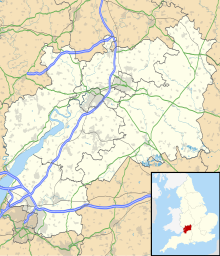Nagshead SSSI
| Site of Special Scientific Interest | |

Example: pied flycatcher - woodland supports good populations at Nagshead
|
|
| Area of Search | Gloucestershire |
|---|---|
| Grid reference | SO608090 |
| Coordinates | 51°46′43″N 2°34′08″W / 51.778738°N 2.568874°WCoordinates: 51°46′43″N 2°34′08″W / 51.778738°N 2.568874°W |
| Interest | Biological |
| Area | 120.12 hectare |
| Notification | 1972 |
| Natural England website | |
Nagshead (grid reference SO608090) is a 120.12-hectare (296.8-acre) biological Site of Special Scientific Interest and is located near Parkend, in the Forest of Dean, Gloucestershire, and was notified in 1972. It lies within the Forest of Dean Forest Park and is part held as a reserve by the Royal Society for the Protection of Birds (RSPB). The SSSI is a relatively small area of the much larger nature reserve of RSPB Nagshead, which is a 1,250 acres (510 ha) site owned and managed by the RSPB and the Forestry Commission. The SSSI lies to the east of the Nagshead Plantation and consists of two units of assessment by Natural England.
The site is listed in the 'Forest of Dean Local Plan Review' as a Key Wildlife Site (KWS).
The woodland in the Forest of Dean has been managed for timber for a significant time. As a consequence there is a variety of woodland types as a result of the woodland management. The central area of woodland is in the Coal Measures and this area supports oak with restricted ground flora. This is an acidic area. Around it are the limestone and Old Red Sandstone rocks. These provide soils which are more fertile and a richer ground flora.
The Nagshead site is one of three sites in the Forest of Dean which are of national nature conservation importance. It is an excellent example of broad-leaved woodland and is of major ornithological importance. The oldest part of the site was planted in 1814 and includes pedunculate oak and sessile oak.
...
Wikipedia

